
Catalog excerpts

Innovative, High Quality Vaccine Production with GEA Technology engineering for a better world
Open the catalog to page 1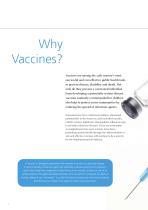
Why Vaccines? Vaccines are among the 20th century’s most successful and cost-effective public health tools to prevent disease, disability and death. Not only do they prevent a vaccinated individual from developing a potentially serious disease, vaccines routinely recommended for children also help to protect entire communities by reducing the spread of infectious agents. Immunisations have eradicated smallpox, eliminated poliomyelitis in the Americas, and controlled measles, rubella, tetanus, diphtheria, Haemophilus influenzae type b and other infectious diseases. These are tremendous...
Open the catalog to page 2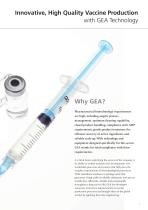
Innovative, High Quality Vaccine Production with GEA Technology Why GEA? Pharmaceutical biotechnology requirements are high, including aseptic process management, optimum cleaning capability, closed product handling, compliance with GMP requirements, gentle product treatment, the efficient recovery of active ingredients and reliable scale-up. With technology and equipment designed specifically for this sector, GEA stands for total compliance with these requirements. A critical factor underlying the success of the company is its ability to swiftly translate new developments into marketable...
Open the catalog to page 3
Vaccine Industry Overview The world market for vaccines was valued at $33.8 billion in 2012. Paediatric vaccination continues to dominate the market, despite patent expiries and the inclusion of governmentprovided basic healthcare at a grass roots level; sector growth is derived from the Pediatric Proprietary vaccine (27% market share in 2009 and expected to increase to 32% by 2015) and Pediatric Enhanced Combination; but, the increased immunisation of adults and the growth of therapeutic vaccines used in cancer treatment are set to drive revenue through to 2022. In terms of number of...
Open the catalog to page 4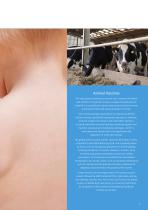
Animal Vaccines The major goals of veterinary vaccines are to improve the health and welfare of companion animals, increase the production of livestock in a cost-effective manner and prevent animal-to-human transmission from both wild and domestic animals. From whole-pathogen preparations to molecularly defined subunit vaccines, genetically engineered organisms or chimeras, vectored antigen formulations and naked DNA injections, successful veterinary vaccines have been produced against viral, bacterial, protozoal and multicellular pathogens, which in many ways have led the field in the...
Open the catalog to page 5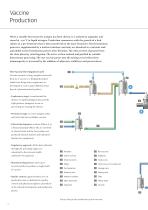
When a suitable host strain for antigen has been chosen, it is isolated in ampoules and stored at -192 °C in liquid nitrogen. Production commences with the growth of a feed culture in a pre-fermenter that is then transferred to the main fermenter. The fermentation process is supplemented by a nutrient solution: nutrients are dissolved in a nutrient tank and added to the fermentation process after filtration. The cells are then separated from the clear phase by centrifugation. The active is then isolated and purified by suitable downstream processing. The raw vaccine passes into the mixing...
Open the catalog to page 6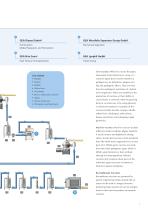
GEA Diessel GmbH Fermentation Media Preparation and Formulation C GEA Niro Soavi High Pressure Homogenization B GEA Westfalia Separator Group GmbH Mechanical Separation D GEA Lyophil GmbH Freeze Drying Live vaccines • Measles • Mumps • Rubella • Yellow fever • Chickenpox • BCG (= tuberculosis vaccine) • Typhus • Human rotaviruses Whooping cough (pertussis) Live vaccines: With live vaccine therapies, attenuated strains (bacteria or virus) or a causative agent that's closely related to a pathogen are, by definition, antigens, but lack the pathogenic effects. They are bred from less-pathogenic...
Open the catalog to page 7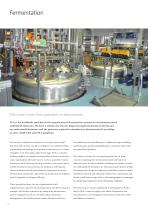
The smart route from upstream to downstream GEA is the worldwide specialist in the manufacture of fermentation systems for the pharmaceutical and biotech industries. We have a solution for all your bioprocessing/fermentation needs because we understand bioreactors and the processes required to manufacture pharmaceuticals according to strict cGMP, FDA and EMA guidelines. All vaccines, whether live (bacteria or viruses), inactivated microfiltration and ultrafiltration. Additional steps including (bacteria and viruses), toxoids or antigens, are produced using sedimentation and...
Open the catalog to page 8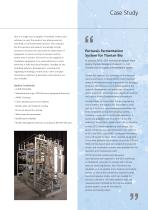
GEA is a single-source supplier of modular systems and solutions to meet the needs of any pharmaceutical, microbial or cell fermentation process. The company has the expertise and industry knowledge to help customers test processes and make the right choice of equipment to ensure security of outcome and the fastest time to market. All vessels can be supplied as standalone equipment or as automated process units delivered as fully functional modules, installed on site, including agitators, homogenisers, metering and regulating technology, control units, valves and pipe connections. Options...
Open the catalog to page 9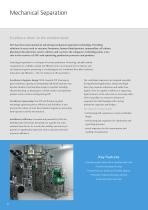
Mechanical Separation Excellence down to the smallest detail GEA has been instrumental in advancing mechanical separation technology. Providing solutions in areas such as enzymes, hormones, human blood proteins, mammalian cell culture, pharmaceutical proteins, starter cultures and vaccines, the company’s technology plays a key role in the recovery of APIs and optimising production processes and products. Centrifugal separation is a vital part of vaccine production. Processing valuable cellular components in a reliable, smooth and efficient way is an economic driver whereas safe and superior...
Open the catalog to page 10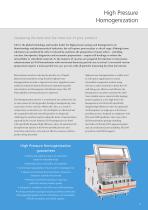
High Pressure Homogenization Squeezing the best and the most out of your product GEA is the global technology and market leader for high-pressure pumps and homogenizers. In biotechnology and pharmaceutical industries, the cell rupture process plays a critical stage. Although some substances are produced by cells or released by autolysis, the preparation of many others – including vaccines, therapeutics, diagnostics and enzymatic preparations – require cell breakage to release the intracellular or subcellular material. As the majority of vaccines are prepared for injection or intravenous...
Open the catalog to page 11All GEA Tiromat Packaging - GEA Food Solutions Germany catalogs and technical brochures
-
consigma-coater-2018-170309
4 Pages
-
Tablet-Compression-171069
48 Pages
-
Pharmaceutical Biotechnology
32 Pages
-
GEA Lyophil LYOPLUS™
2 Pages










